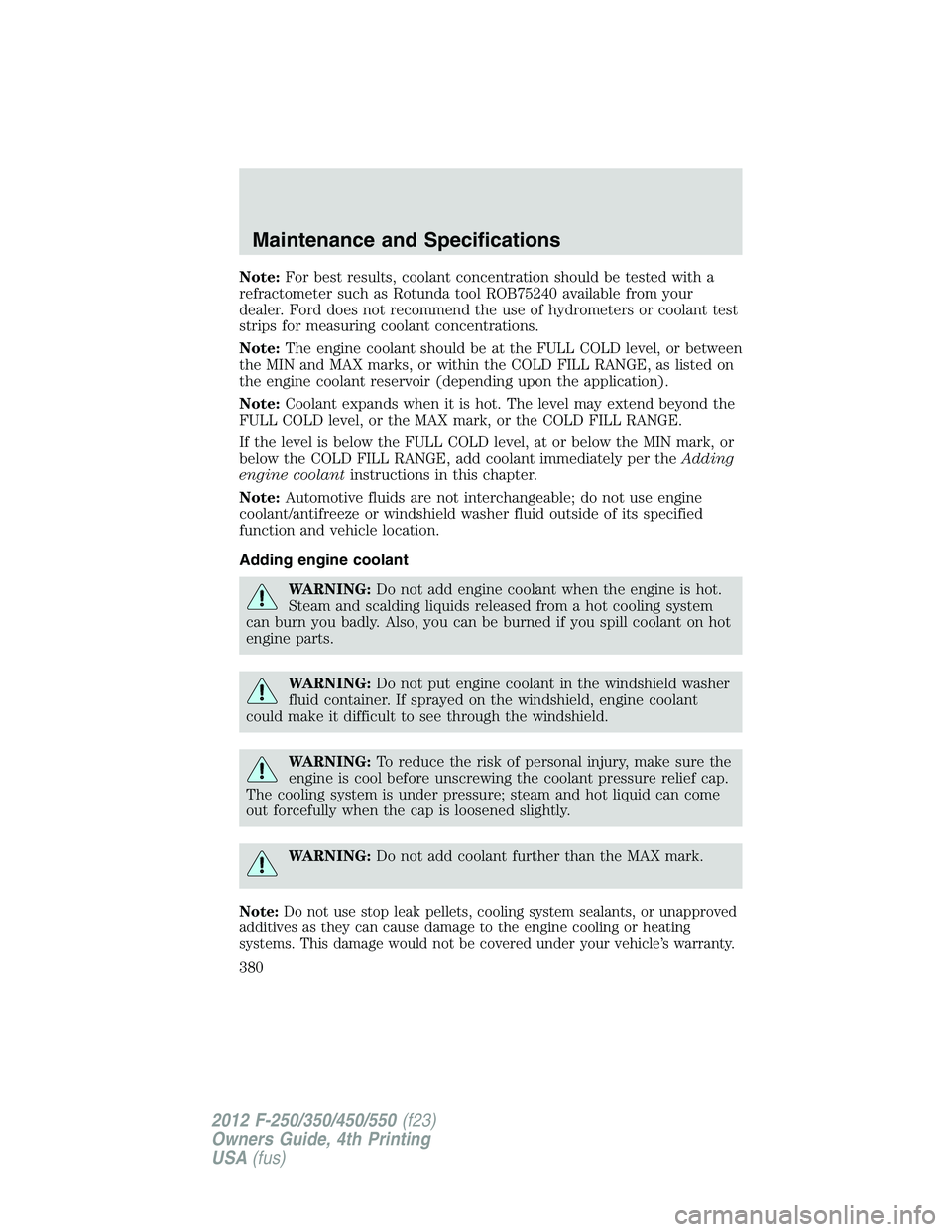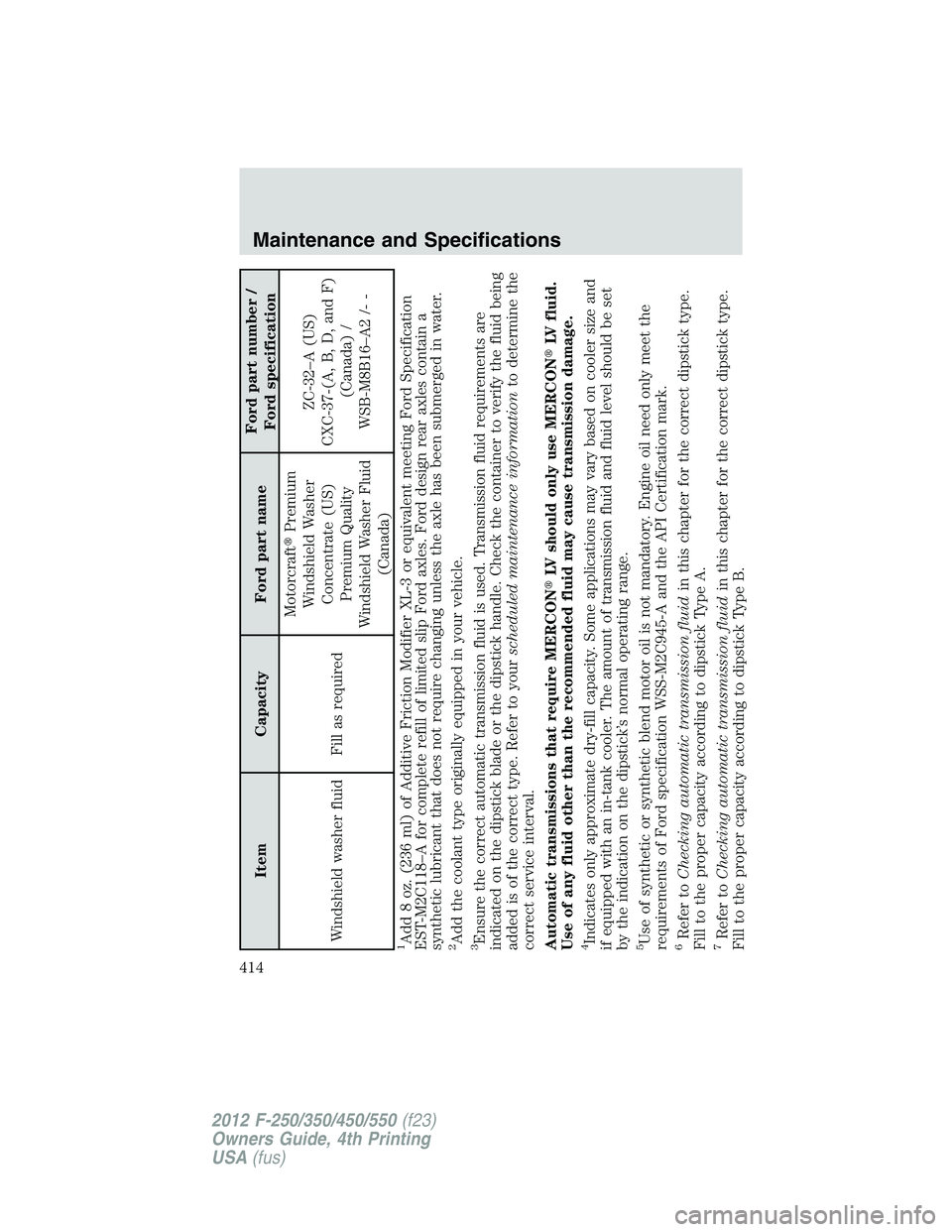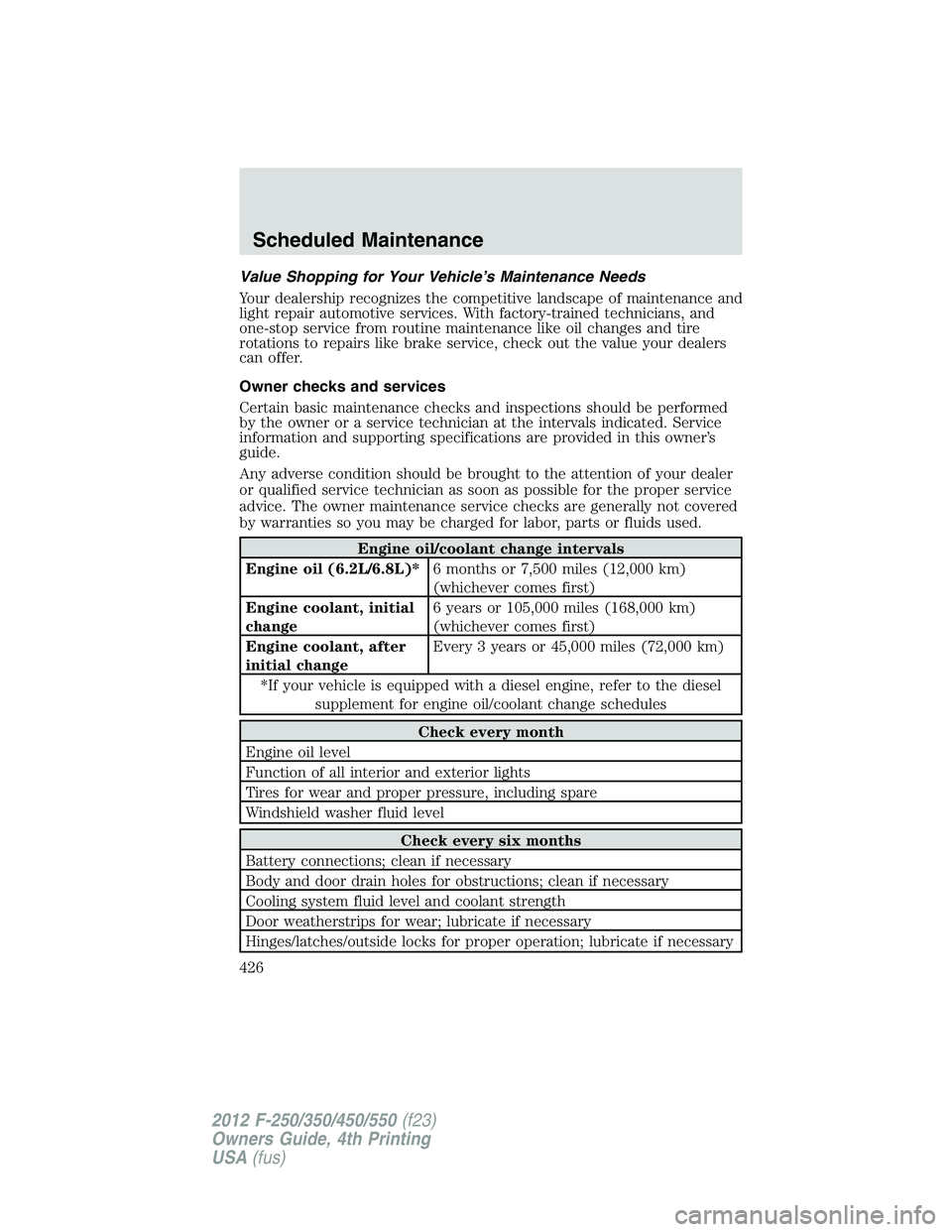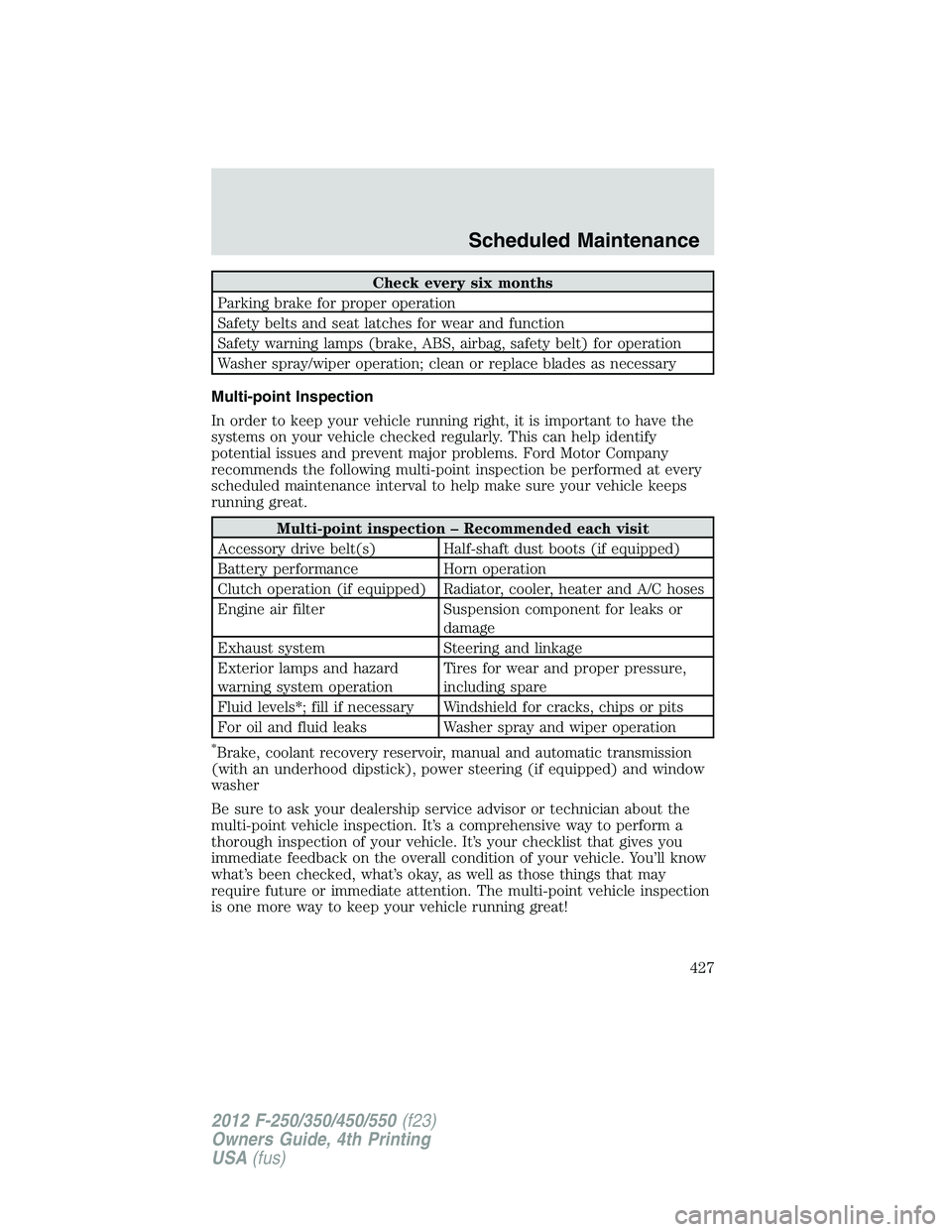Page 380 of 448

Note: For best results, coolant concentration should be tested with a
refractometer such as Rotunda tool ROB75240 available from your
dealer. Ford does not recommend the use of hydrometers or coolant test
strips for measuring coolant concentrations.
Note: The engine coolant should be at the FULL COLD level, or between
the MIN and MAX marks, or within the COLD FILL RANGE, as listed on
the engine coolant reservoir (depending upon the application).
Note: Coolant expands when it is hot. The level may extend beyond the
FULL COLD level, or the MAX mark, or the COLD FILL RANGE.
If the level is below the FULL COLD level, at or below the MIN mark, or
below the COLD FILL RANGE, add coolant immediately per the Adding
engine coolant instructions in this chapter.
Note: Automotive fluids are not interchangeable; do not use engine
coolant/antifreeze or windshield washer fluid outside of its specified
function and vehicle location.
Adding engine coolant
WARNING: Do not add engine coolant when the engine is hot.
Steam and scalding liquids released from a hot cooling system
can burn you badly. Also, you can be burned if you spill coolant on hot
engine parts.
WARNING: Do not put engine coolant in the windshield washer
fluid container. If sprayed on the windshield, engine coolant
could make it difficult to see through the windshield.
WARNING: To reduce the risk of personal injury, make sure the
engine is cool before unscrewing the coolant pressure relief cap.
The cooling system is under pressure; steam and hot liquid can come
out forcefully when the cap is loosened slightly.
WARNING: Do not add coolant further than the MAX mark.
Note: Do not use stop leak pellets, cooling system sealants, or unapproved
additives as they can cause damage to the engine cooling or heating
systems. This damage would not be covered under your vehicle’s warranty.Maintenance and Specifications
380
2012 F-250/350/450/550 (f23)
Owners Guide, 4th Printing
USA (fus)
Page 414 of 448

Item Capacity Ford part name Ford part number /
Ford specification
Windshield washer fluid Fill as required Motorcraft � Premium
Windshield Washer
Concentrate (US)
Premium Quality
Windshield Washer Fluid
(Canada) ZC-32–A (US)
CXC-37-(A, B, D, and F)
(Canada) /
WSB-M8B16–A2 /- -
1Add 8 oz. (236 ml) of Additive Friction Modifier XL-3 or equivalent meeting Ford Specification
EST-M2C118–A for complete refill of limited slip Ford axles. Ford design rear axles contain a
synthetic lubricant that does not require changing unless the axle has been submerged in water.
2Add the coolant type originally equipped in your vehicle.
3Ensure the correct automatic transmission fluid is used. Transmission fluid requirements are
indicated on the dipstick blade or the dipstick handle. Check the container to verify the fluid being
added is of the correct type. Refer to your scheduled maintenance information to determine the
correct service interval.
Automatic transmissions that require MERCON � LV should only use MERCON � LV fluid.
Use of any fluid other than the recommended fluid may cause transmission damage.
4Indicates only approximate dry-fill capacity. Some applications may vary based on cooler size and
if equipped with an in-tank cooler. The amount of transmission fluid and fluid level should be set
by the indication on the dipstick’s normal operating range.
5Use of synthetic or synthetic blend motor oil is not mandatory. Engine oil need only meet the
requirements of Ford specification WSS-M2C945-A and the API Certification mark.
6Refer to Checking automatic transmission fluid in this chapter for the correct dipstick type.
Fill to the proper capacity according to dipstick Type A.
7Refer to Checking automatic transmission fluid in this chapter for the correct dipstick type.
Fill to the proper capacity according to dipstick Type B.Maintenance and Specifications
414
2012 F-250/350/450/550 (f23)
Owners Guide, 4th Printing
USA (fus)
Page 426 of 448

Value Shopping for Your Vehicle’s Maintenance Needs
Your dealership recognizes the competitive landscape of maintenance and
light repair automotive services. With factory-trained technicians, and
one-stop service from routine maintenance like oil changes and tire
rotations to repairs like brake service, check out the value your dealers
can offer.
Owner checks and services
Certain basic maintenance checks and inspections should be performed
by the owner or a service technician at the intervals indicated. Service
information and supporting specifications are provided in this owner’s
guide.
Any adverse condition should be brought to the attention of your dealer
or qualified service technician as soon as possible for the proper service
advice. The owner maintenance service checks are generally not covered
by warranties so you may be charged for labor, parts or fluids used.
Engine oil/coolant change intervals
Engine oil (6.2L/6.8L)* 6 months or 7,500 miles (12,000 km)
(whichever comes first)
Engine coolant, initial
change 6 years or 105,000 miles (168,000 km)
(whichever comes first)
Engine coolant, after
initial change Every 3 years or 45,000 miles (72,000 km)
*If your vehicle is equipped with a diesel engine, refer to the diesel
supplement for engine oil/coolant change schedules
Check every month
Engine oil level
Function of all interior and exterior lights
Tires for wear and proper pressure, including spare
Windshield washer fluid level
Check every six months
Battery connections; clean if necessary
Body and door drain holes for obstructions; clean if necessary
Cooling system fluid level and coolant strength
Door weatherstrips for wear; lubricate if necessary
Hinges/latches/outside locks for proper operation; lubricate if necessaryScheduled Maintenance
426
2012 F-250/350/450/550 (f23)
Owners Guide, 4th Printing
USA (fus)
Page 427 of 448

Check every six months
Parking brake for proper operation
Safety belts and seat latches for wear and function
Safety warning lamps (brake, ABS, airbag, safety belt) for operation
Washer spray/wiper operation; clean or replace blades as necessary
Multi-point Inspection
In order to keep your vehicle running right, it is important to have the
systems on your vehicle checked regularly. This can help identify
potential issues and prevent major problems. Ford Motor Company
recommends the following multi-point inspection be performed at every
scheduled maintenance interval to help make sure your vehicle keeps
running great.
Multi-point inspection – Recommended each visit
Accessory drive belt(s) Half-shaft dust boots (if equipped)
Battery performance Horn operation
Clutch operation (if equipped) Radiator, cooler, heater and A/C hoses
Engine air filter Suspension component for leaks or
damage
Exhaust system Steering and linkage
Exterior lamps and hazard
warning system operation Tires for wear and proper pressure,
including spare
Fluid levels*; fill if necessary Windshield for cracks, chips or pits
For oil and fluid leaks Washer spray and wiper operation *
Brake, coolant recovery reservoir, manual and automatic transmission
(with an underhood dipstick), power steering (if equipped) and window
washer
Be sure to ask your dealership service advisor or technician about the
multi-point vehicle inspection. It’s a comprehensive way to perform a
thorough inspection of your vehicle. It’s your checklist that gives you
immediate feedback on the overall condition of your vehicle. You’ll know
what’s been checked, what’s okay, as well as those things that may
require future or immediate attention. The multi-point vehicle inspection
is one more way to keep your vehicle running great! Scheduled Maintenance
427
2012 F-250/350/450/550 (f23)
Owners Guide, 4th Printing
USA (fus)
Page 448 of 448
W
Warning lights (see Lights) .......14
Washer fluid ..............................374
Water, Driving through .............315
Windows
power .......................................103 Windshield washer fluid and
wipers
..........................................98
checking and adding fluid
.....374
replacing wiper blades
...........374
Wrecker towing
.........................351
Index
448
2012 F-250/350/450/550 (f23)
Owners Guide, 4th Printing
USA (fus)